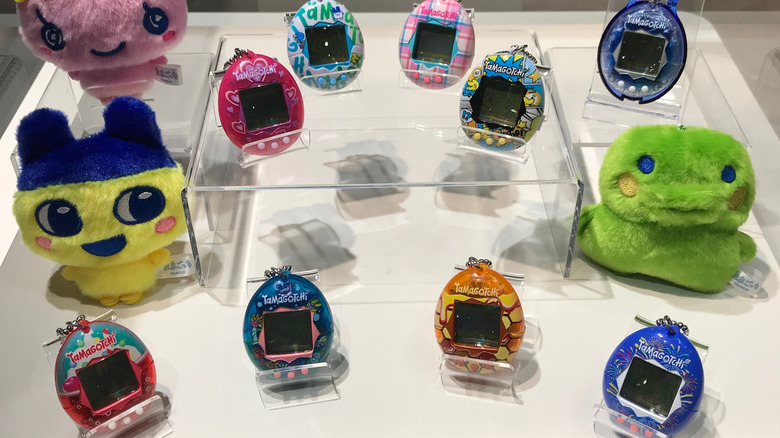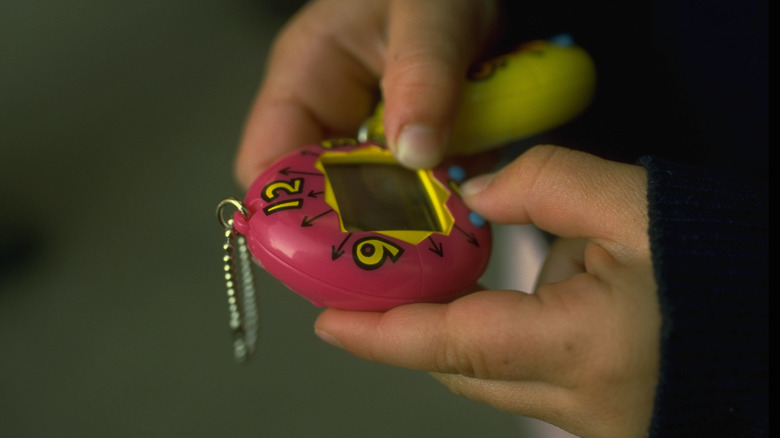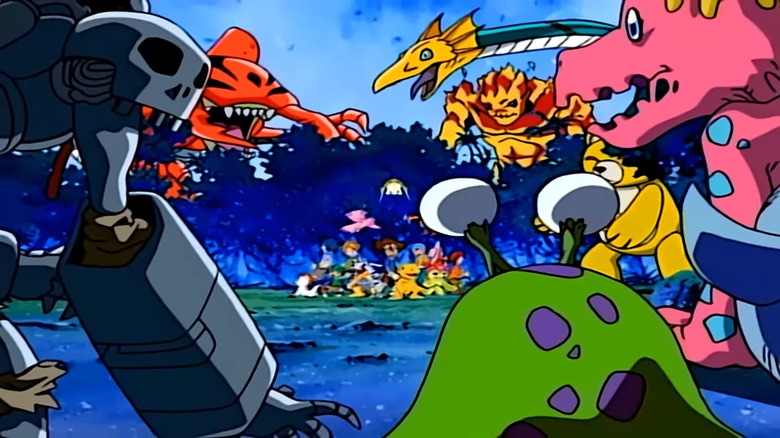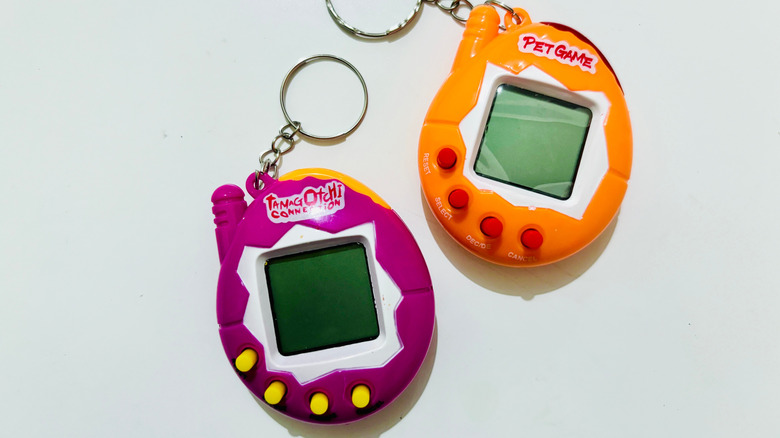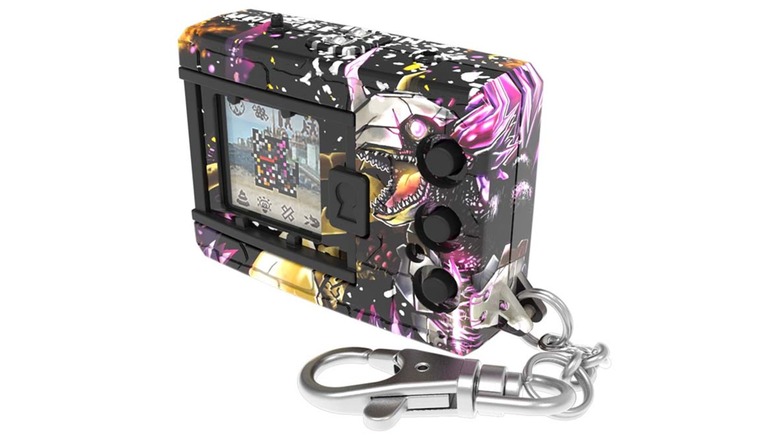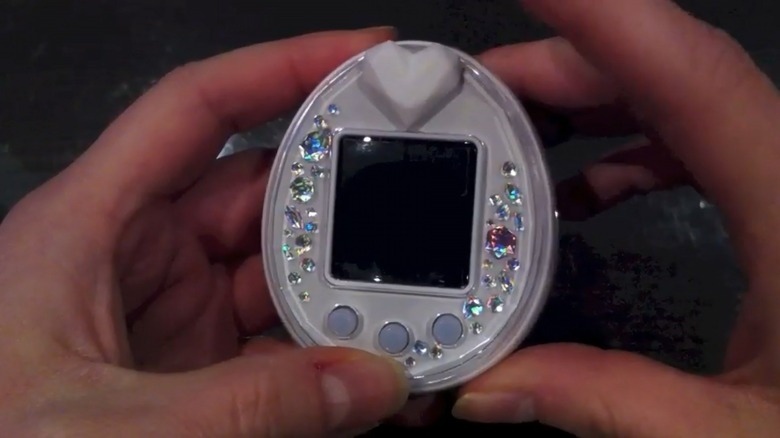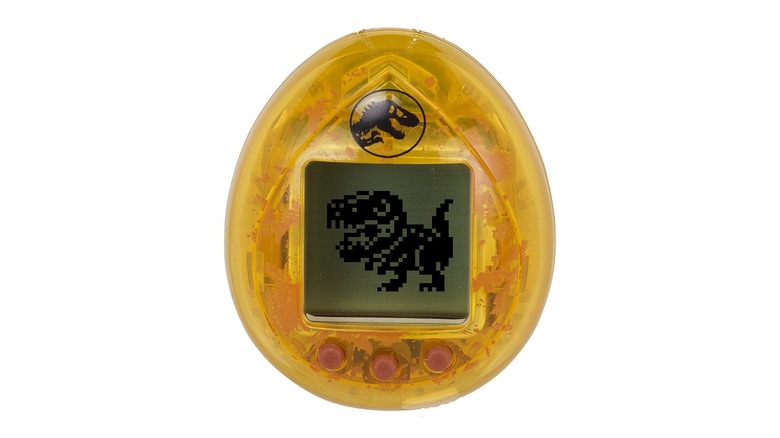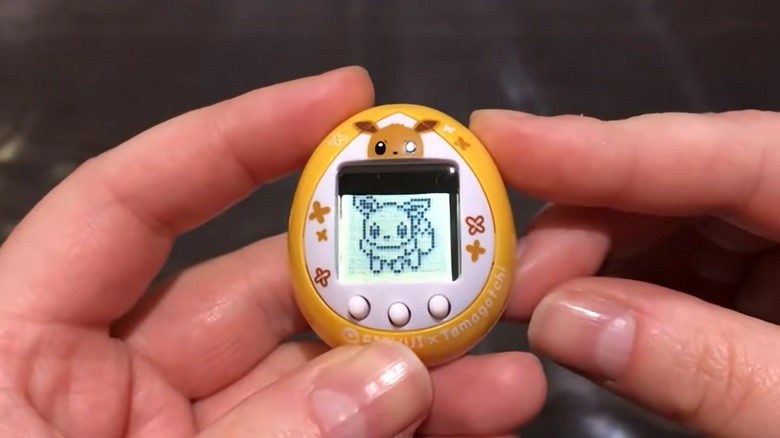Why Is Tamagotchi Popular Again, And Which Are Most Valuable Now?
While time and technology are always marching forward, every now and then we yearn to relive the past, or at least own devices intentionally designed to mimic it. We've done it with modern cars that look like retro classics, and we've done it with gadgets that look like retro devices. One of the more intriguing examples of the latter is the Tamagotchi.
For those who missed out, Tamagotchi were and are small devices with LCD screens that fit in your pocket. Bandai's core design principle revolved around the simple and addictive premise of caring for virtual, pixelated critters — the titular Tamagotchis. Depending on what players did, their Tamagotchi could "evolve" into one of several forms. These toys provided almost all the fun of owning and caring for a pet without the messy hassle of training or cleaning up after it. And Tamagotchi toys came in a variety of cute, pastel colors.
While the Tamagotchi was prodigiously popular when it originally released, the fad eventually died off. Bandai brought the line back in the late 2000s, but it didn't catch on. However, the latest generation has proven a resounding success, so much so that in 2024, Bandai opened the world's first store dedicated to Tamagotchi products...in London. But just what is fueling this fervor, and which Tamagotchi are people most interested in these days?
Never underestimate the power of nostalgia
In the world of video games, aesthetics trump graphical fidelity. Many gamers still love the polygonal and pixelated games of yesteryear and often go out of their way to purchase these retro consoles. Much of that same energy powers the Tamagotchi revival.
You can sum up most of the driving force behind the current Tamagotchi craze in one word: nostalgia. Many of the people currently purchasing the new line of toys grew up playing with the originals back in the 90s, and they are craving the ability to relive those moments in the modern era. Since few saved their Tamagotchis or have working ones, if people want to embrace the nostalgia, they must buy the new Tamagotchis. Given how all these sales have fueled new products (more on those later), that's a worthwhile sacrifice.
The appeal of Tamagotchi also has the potential to attract new players who never grew up with the original devices. The simple gameplay loop is a change of pace for young gamers who mostly rely on mobile games. No waiting for timers to complete, no grinding through missions intentionally designed to make you pay money to skip them. Just a constant and addictive stream of fun caring for a pretend pet. What modern gamer wouldn't be interested?
Two sides of the same coin: Tamagotchi and Digimon
The Tamagotchi line was designed for girls, but Bandai had plans to apply the same magic to capture a male demographic. The result was Digimon, which went in its own direction and is now very much a separate property. These toys still play a role in the current Tamagotchi resurrection.
The popularity of Digimon, which feeds into the current popularity of Tamagotchi, is a two-pronged nostalgia attack. The first factor is the Digimon toys, which are similar to Tamagotchi, but instead of caring for pixelated pixies, these devices let users train dot-matrix dinosaurs. Nostalgia for this experience hits the same notes as the nostalgia surrounding other Tamagotchis, because they are almost one-to-one the same experience. However, Digimon also had the added feature of letting players compete in PvP matches.
The second element in Digimon's current success is its cross-media presence. Unlike Tamagotchi, after the fad behind the digital pet toys died down, Digimon persisted through video games and anime shows. Fans have fond memories of the various "Digimon" TV series, especially the first one (which has an earworm of a theme song in both Japanese and English). And while console "Digimon" games are somewhat niche, they've proven popular enough to sell millions of copies. These shows and games have likely circled back to help push sales of the current toys, but without the original run of Digimon digital pets — and Tamagotchi — they wouldn't exist in the first place.
New technology in a retro package
When Bandai released the original Tamagotchi and Digimon lines, the devices were limited by the technology of the time. Heck, companies had yet to fully channel the power of the LR44 battery. But like many modern items that ape retro tech, the mimicry is only skin deep.
Externally, current Tamagotchi and Digimon are either identical to or heavily resemble earlier runs of the toys. Tamagotchi Connection even still relies on infrared technology. However, these toys have more modern additions, such as backlit displays, and some models go even further. The Tamagotchi On has full color sprites and changing backgrounds. The watch-like Tamagotchi Uni brings classic Tamagotchi characters to life with even more detailed displays and Wi-Fi functionality.
While quite a few new Tamagotchis try to recreate the original experience, the modern Digimon line is more concerned with providing a complete package. Like current Tamagotchis, these Digimon devices recreate the original Digimon toy's appearance, but their chips house the entire roster of trainable monsters from multiple toy generations, including some that previously never appeared outside of Japan. Plus, the current version lets users raise two Digimon at once — twice the number of the origin, twice the fun. Oh, and some recent Digimon toys traded their reliance on LR44s for rechargeable batteries. How Bandai's engineers packed all that power into the same small package is a miracle.
Crossovers means there's a Tamagotchi for everyone
The Tamagotchi and Digimon lines mostly rely on a roster of novel characters that don't appear outside of the toys and their cross-media adaptations. However, sometimes the best way to attract attention is to take a concept like caring for a digital pet, and wrap it in the skin of an existing property people already love.
Currently, the Tamagotchi Nano line — Tamagotchi devices even smaller than the standard series – only consists of digital pets based on licensed franchises. People can buy devices that let them raise their own character from popular Japanese franchises such as "Hello Kitty," "Gudetama," "Hatsune Miku," and even anime like "Spy x Family" and "One Piece." And the Tamagotchi Nano brand is no stranger to Western properties — you can raise your own Buzz Lightyear, "Jurassic Park" dinosaur, or even Darth Vader. Yes, seriously.
While the Tamagotchi Nano offers the lion's share of crossover digital pets, the team behind Digimon might be putting even more effort into its crossovers. So far, Digimon has only two series of crossover devices, but they're more thematically appropriate, as they let players raise digital monsters from "Godzilla" and "Monster Hunter," as well as fusions of fan-favorite Digimon and creatures from the respective lines. Not only do these crossovers help celebrate the anniversaries of their properties, but the "Godzilla" model finally lets the Digimon series come full circle, since the final generation of the original devices was originally envisioned as a crossover with "Godzilla." Better late than never.
Rare models fetch high prices
When you think about valuable Tamagotchi toys, your mind probably jumps to the original run of digital pets since they are over two decades old. Any game from that era that either still works or is in its original packaging is worth some money. Assuming your definition of "some money" is three to four figures.
If you have an old Tamagotchi laying around, it is probably worth more than you think. They won't fetch as much as the most valuable retro video games, but they're still worth plenty of cash. Currently, the most expensive Tamagotchi on the market is the Tamagotchi P's (the "P" stands for "pierce"). These old, limited-edition devices came with color screens and could be customized with collectable pins that unlocked exclusive content. The pure pink Tamagotchi P's is selling for close to $2,000 on eBay.
While most rare classic Tamagotchi models don't fetch as high a price as the pink Tamagotchi P's, they are still being sold for serious money. For instance, the limited edition white Santa Claus-themed Tamagotchi, Santaclautchi, is selling for $235. Meanwhile, a Devil-themed Tamagotchi, Devilgotchi (Japanese designers often use Judeo-Christian iconography), goes for $739.96. More often than not, the rare Japanese-exclusive models are regarded as the most valuable, even if they aren't mint-in-box.
Some models are selling out
Another criterion to measure an item's value is to use the age-old "supply and demand." If more people demand an item than a manufacturer can supply, and the item sells out, then it's generally considered valuable. This is true for several Tamagotchi models and Digimon devices.
Depending on where you shop, you might find a surplus or shortage of Tamagotchi toys. Shopping on Amazon, for instance, reveals countless Tamagotchi Original devices still in stock. However, the more advanced Tamagotchi Ons are all sold out, and Tamagotchi Nano availability is a roll of the dice. Want a "One Piece" or a "Star Wars" digital pet? They're in stock (at time of writing). "Hatsune Miku" and "Jurassic Park" models? All gone. And Digimon aficionados will have an even harder time.
Most of the 20th Anniversary Digimon devices are sold out on stores such as Amazon and BigBadToyStore. As for the Digimon crossover toys, much like Tamagotchi Nanos, availability is a mixed bag. Currently, the "Godzilla" and "Monster Hunter" devices are sold on storefronts that specialize in Japanese products (including BigBadToyStore), but that wasn't always the case. The "Monster Hunter" digital pets were so popular that they initially sold out, so Bandai put a second wave up for pre-order. Some stores still have both "Monster Hunter" toy styles, while others only have one and not the other. Apparently fans would rather raise a Zinogre over a Rathalos.
Not all models are available Stateside
Bandai has occasionally used Tamagotchi as a gateway to share properties that don't have much of a presence in the West. We previously mentioned the Tamagotchi featuring "Gudetama," but the company has also produced Tamagotchi Nano based on the live-action series "Kamen Rider," as well as Korean boy band BTS. These are available through sites such as Amazon, but the same can't be said for all Tamagotchi pets.
Much like the Japanese video game industry, Bandai has released quite a few Tamagotchi toys only available in Japan, or in online storefronts that specialize in Japanese toys and products. Some of these Japan-exclusive Tamagotchi include digital pets based on Hololive VTubers and Eevee and the eeveelutions from "Pokémon." Confusingly enough, more people probably know about these properties in the U.S. than "Kamen Rider."
Since these Japan-exclusive Tamagotchis don't have any official Western releases, if you want one, you must buy them through third-party sellers. This means higher prices across the board. The Hololive Tamagotchi, for instance, are $100 on Zenintcg.com — $80 for the toy and $20 for shipping — despite being a Tamagotchi Nano, which are generally priced around $20. The "Pokémon" Eevee Tamagotchi, meanwhile, aren't produced anymore, so anyone who wants one has to go through eBay and spend at least $150 for a new copy. Buying these digital pet makes trying to find the Japanese eShop on a Nintendo Switch sound easy by comparison.
